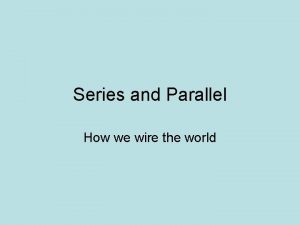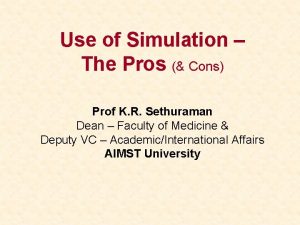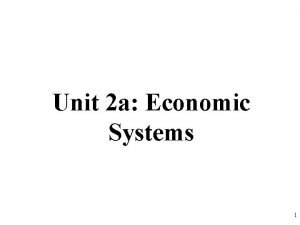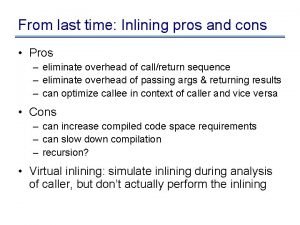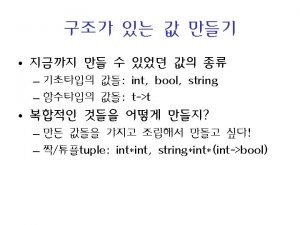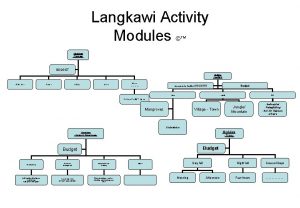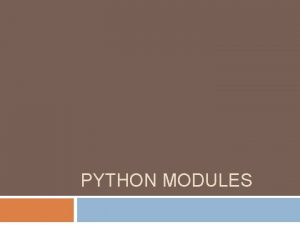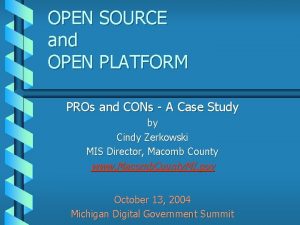Reflections on the pros and cons of modules






















- Slides: 22

Reflections on the pros and cons of modules, deployment mechanisms and development strategies Paolo Spada Centre for the Study of Democratic Institutions Prepared for the PP conference June 12 -14 2015

The challenge: can a survey fit them all? 1) Large variety of processes 2) Global scale 3) Large variety of disciplines, approaches and research designs 4) Different expertise and interests in the PP network

Can modules be the answers? Trade-offs: a) PROS • Inject flexibility and more specialization • Allow scalability • Allow the creation of multiple products for different audiences • Allow for more experimentalism • Allow more occasions for synergy with partners’ interests a) CONS • Reduce comparability across cases • Generate more complexity

Examples of increased flexibility a) Number of questions (e. g. , create a minimal core)

Examples of increased flexibility a) Number of questions (e. g. , create a b) Type minimal core)of respondent (e. g. , participant vs organizer vs other; academic expert vs academic non-expert; practice expert vs practice non-expert).

Examples of increased flexibility c) Special topic (e. g. , some mightcreate be interested in a) Number ofresearchers questions (e. g. , a b) Type of respondent (e. g. , psychometrics) participant advanced minimal core)exploring vs organizer vs other; academic expert vs academic non-expert; practice expert vs practice non-expert).

Examples of increased flexibility a) Number of questions (e. g. , create a b) Type minimal core)of respondent (e. g. , participant vs organizer vs other; academic d) Deployment method expert (e. g. , single vs vs academic non-expert; multiple) c) Special topic (e. g. , practice some expert vs practicemight non-expert). researchers be interested in exploring advanced psychometrics)

Examples of increased flexibility a) Number of questions e) Primary (e. g. , research create a method (e. g. , b) Type (e. g. , participant minimal core)of respondent qualitative vs quantitative) vs organizer vs other; academic d) Deployment method expert (e. g. , single vs vs academic non-expert; multiple) c) Special topic (e. g. , practice some expert vs practicemight non-expert). researchers be interested in exploring advanced psychometrics)

Examples of increased flexibility a) Number of questions e) Primary (e. g. , research create a method (e. g. , b) Type (e. g. , participant minimal core)of respondent qualitative vs quantitative) vs organizer vs other; academic d) Deployment method expert (e. g. , single vs f) Famous methodologies (e. g. , PB, vs academic non-expert; multiple) c) Special topic (e. g. , practice some CA, DP, CJ, ICT) in expert vs practicemight non-expert). researchers be interested exploring advanced psychometrics)

Examples of increased flexibility a) Number of questions e) Primary (e. g. , research create a method (e. g. , b) Type (e. g. , participant minimal core)of respondent qualitative vs quantitative) vs organizer vs other; academic d) Deployment method expert (e. g. , single vs f) Famous methodologies (e. g. , PB, vs academic non-expert; multiple) c) Special topic (e. g. , practice some CA, DP, CJ, ICT) in expert vs practicemight non-expert). researchers be interested exploring advanced psychometrics) g) Mapping & engagement purpose (e. g. , yelp for democracy)

Examples of increased flexibility a) Number of questions e) Primary (e. g. , research create a method (e. g. , b) Type (e. g. , participant minimal core)of respondent qualitative vs quantitative) vs organizer vs other; academic d) Deployment method expert (e. g. , single vs f) Famous methodologies (e. g. , PB, vs academic non-expert; multiple) c) Special topic (e. g. , practice some CA, DP, CJ, ICT) in expert vs practicemight non-expert). researchers be interested h) Adapting to practitioners’ special exploring advanced psychometrics) interests (e. g. , network development) g) Mapping & engagement purpose (e. g. , yelp for democracy)

PART II: how should we deliver the survey?

A census of common e-survey and expert surveys delivery methods 1) Open, small/medium surveys 2) Closed, small/medium surveys 4) Surveys embedded in an online participatory event X 3) Closed, large surveys (50 to 200 questions) Census link: https: //goo. gl/f. Skd 83

A census of common e-survey and expert surveys delivery methods 1) Open, small/medium surveys 2) Closed, small/medium surveys 1) Open, small surveys They are disseminated both via websites and via email. 4) Surveys embedded in an online participatory event • Given the open nature of these surveys it is impossible to judge the potential target Closed, large surveys population and 3)the answer rate. X (50 to 200 questions) Census link: https: //goo. gl/f. Skd 83

A census of common e-survey and expert surveys delivery methods 1) Open, small/medium surveys 2) Closed, small/medium surveys The dissemination strategy is through mail-lists or membership in an organization. 4) Surveys embedded in an online participatory populations. event • These surveys tend to target large For example there was a survey on climate change that targeted the large top surveys 1% scholars in term 3) Closed, (50 to. Answer 200 questions) of articles published. rate varies. X Census link: https: //goo. gl/f. Skd 83

A census of common e-survey and expert surveys delivery methods 1) Open, small/medium 2) Closed, surveys 2) Closed, small/medium largesurveys The dissemination strategy is through personal contact or membership in an organization. 4) Surveys embedded in an online participatory forms eventof horizontal • Some of these employ also various interactions among the experts (Delphi method and similar). X 3) Closed, large surveys (50 to 200 questions) • Some of these surveys contain more than 200 questions. • From what I can gather they target small (5 to 50) to medium (100 to 500) sets of experts. Census link: https: //goo. gl/f. Skd 83

A census of common e-survey and expert surveys delivery methods 1) Open, small/medium surveys 2) Closed, small/medium surveys 4) Surveys that are embedded in a real life online participatory event. 4) Surveys embedded in • The answer rate varies, I implemented an online participatory event one with 54% and 600 participants, but voting was tied to the survey, and one 3) Closed, large surveys with 18% and 200, 000 participants in (50 to 200 questions) which the survey was voluntary. X Census link: https: //goo. gl/f. Skd 83

Different survey deployment methods 1) A single channel of survey deployment is the classic system. Currently 1800 members, ~300 case writers. 2) A non-integrated multi-channel strategy uses multiple parallel methodologies of survey deployment. 3) An omni-channel or integrated multi-channel strategy is based on an integration set of information that creates a unique ID per respondent and allows to combine information from different channels.

PART III: how should we integrate the modules?

Module Integration Approaches: Method A: big-bang integration • Collect all the possible questions in English from all partners • Identify together a global core and an initial set of modules • Translate them to local languages and ask partners to deploy them • Collect feedback, and update the survey • Create additional modules when the necessity arises and on the basis of partners expertise

Module Integration Approaches: Method B: bottom-up integration • Have partners generate modules dedicated to their expertise and regions in their own language and then translate them to English • In the short-run forego a global census, for more specialized regional and methodology specific censuses • Only later begin identifying common set of questions and synergies across regions and expertise

I usually cite Gramsci at the end. . …but given we got 2. 5 million dollars to run this crazy project,
 Hub and spoke airline
Hub and spoke airline What is an interpreter
What is an interpreter Pros and cons of byod and cobo
Pros and cons of byod and cobo Pros and cons of parallel and series circuits
Pros and cons of parallel and series circuits Pros and cons of artificial nutrition and hydration
Pros and cons of artificial nutrition and hydration Objective and task method pros and cons
Objective and task method pros and cons Discussing advantages and disadvantages
Discussing advantages and disadvantages Trebuchet vs catapult pros and cons
Trebuchet vs catapult pros and cons Doas.exceed lms
Doas.exceed lms Waldorf pros and cons
Waldorf pros and cons Virtual job fairs pros and cons
Virtual job fairs pros and cons Vertical farming pros and cons
Vertical farming pros and cons Pros and cons of kinesthetic learning
Pros and cons of kinesthetic learning Histogram vs boxplot pros and cons
Histogram vs boxplot pros and cons Command economy pros and cons
Command economy pros and cons Cons of proscenium stage
Cons of proscenium stage Who governs a dictatorship
Who governs a dictatorship Pros and cons of trade unions
Pros and cons of trade unions Pros and cons of dictatorship
Pros and cons of dictatorship Act definition government
Act definition government Is german hard to learn
Is german hard to learn Cons of imperialism
Cons of imperialism Pros and cons of telephone interviews
Pros and cons of telephone interviews



